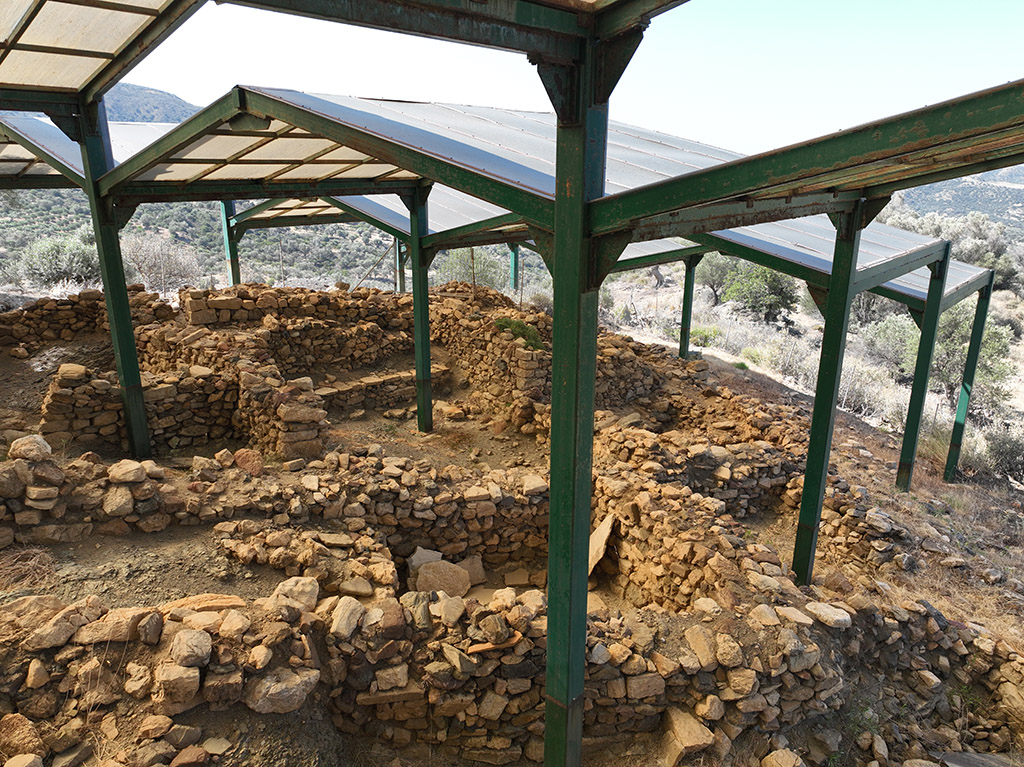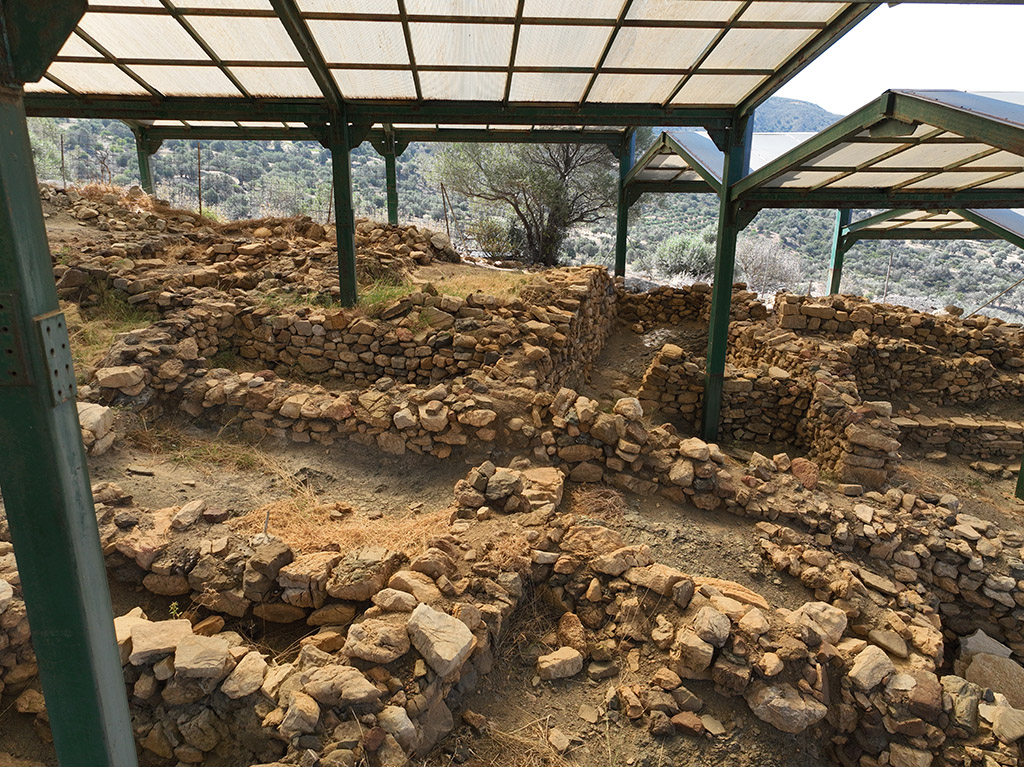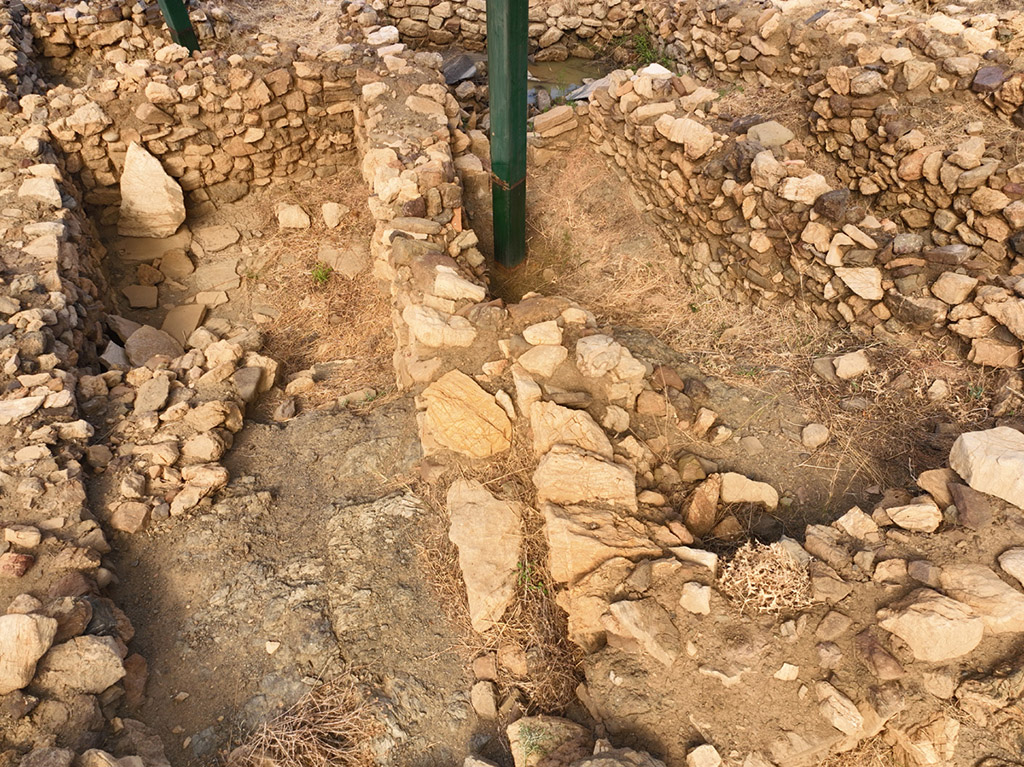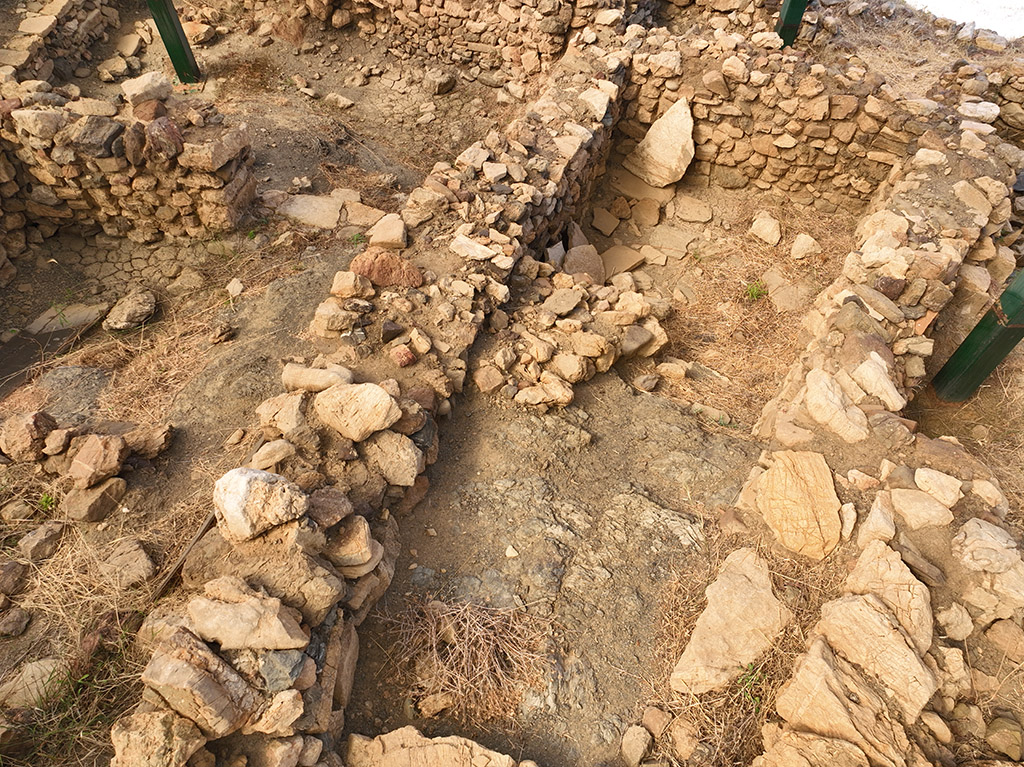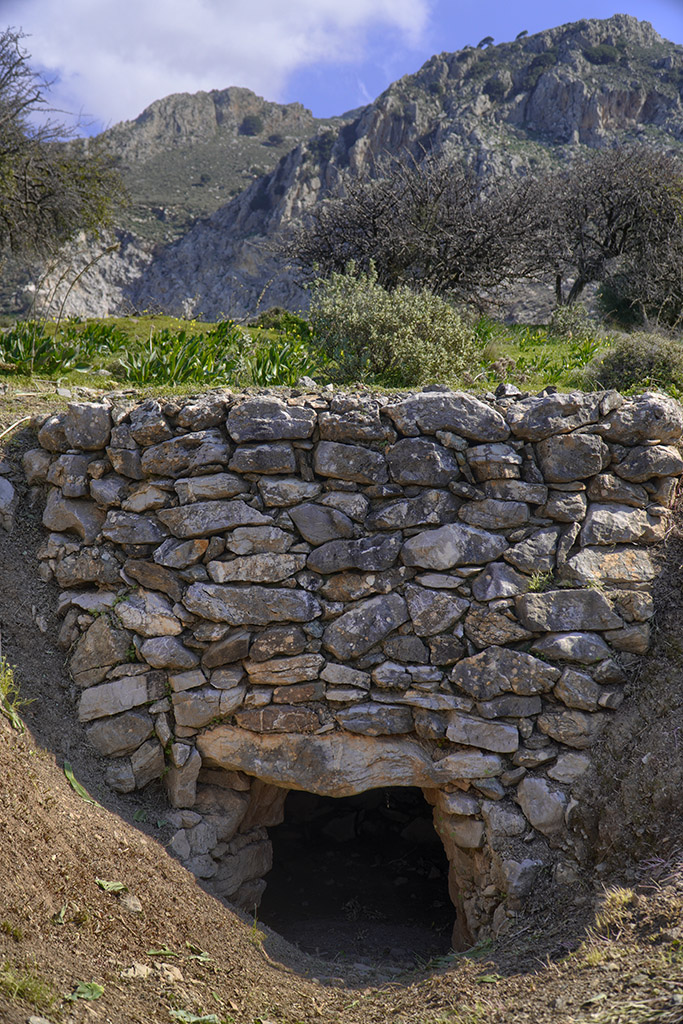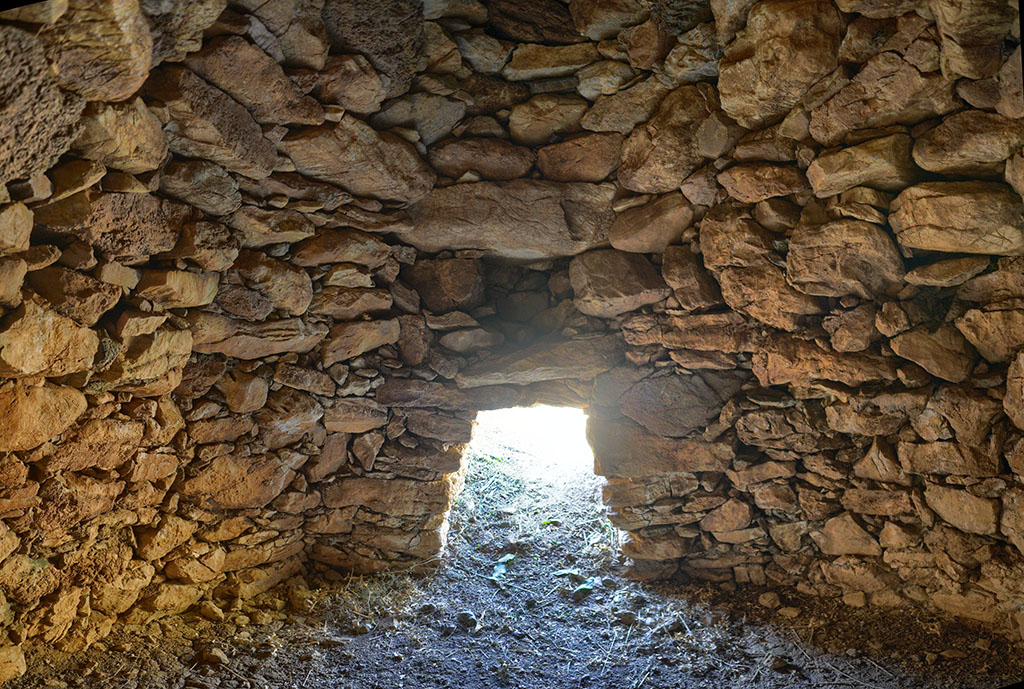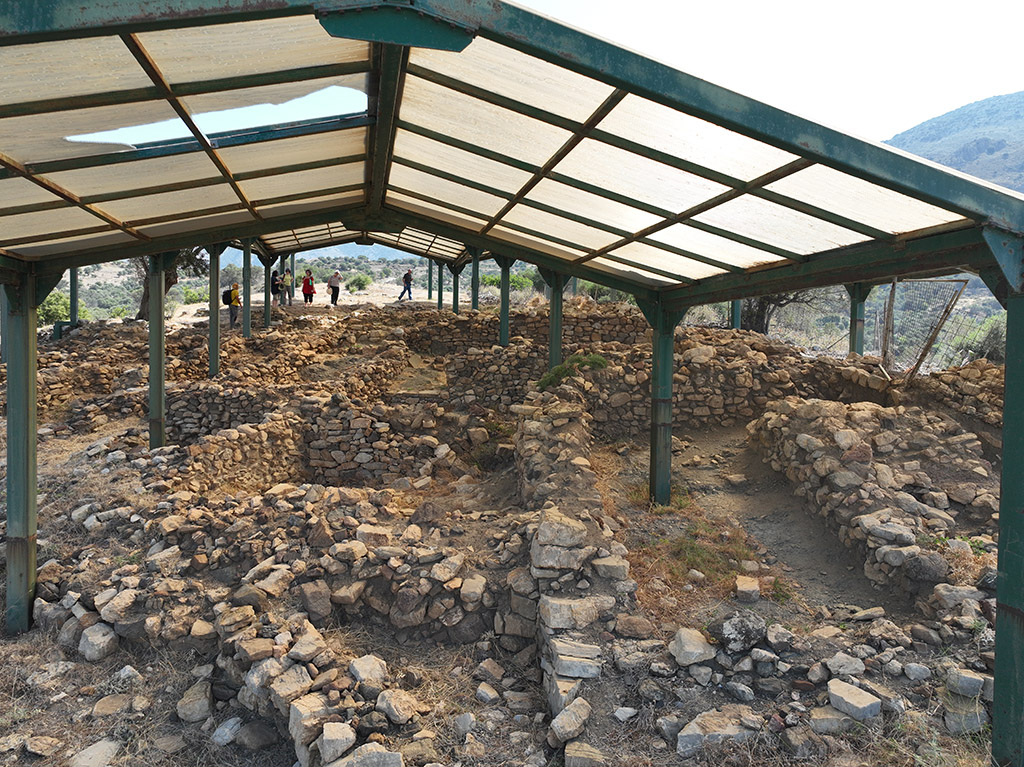
General view of the archaeological site in Apodoulou of Amari from the SW.
The archaeological site οf Apodoulou in Amari
The protopalatial settlement of Apodoulou dominates a low hill called by the locals ' Tou Digeni to chalkoma' or 'Gournes'. It is strategically located on the natural road that connects it with the palatial center of Monastiraki (18 km W) and the palace of Phaistos (20 km SE). In 1930, test trenches, made by Professor Sp. Marinatos, revealed traces of a neopalatial installation (Sector 1) and yielded, among other finds, parts of three stone vases with Linear A script. During World War II, a short excavation was carried out in the southern part of the hill by the German archaeologist E. Kirsten (1951). During the period 1985-2005, the site was excavated by a Greek-Italian archaeological mission under the direction of the Emeritus General Director of Antiquities of the Ministry of Culture, Dr. Yiannis Tzedakis and the Professor of the University of Naples, Federico II, Louis Godart, bringing to light an important Minoan protopalatial settlement.
The main settlement dates back to the Protopalatial period (circa 1900-1700 BC) and was destroyed by fire at the end of the period. After the destruction, the site was used during the next period, the Neopalatial (1700-1650 BC). The overall area of the settlement is estimated at 3.500 sq.m. The excavated protopalatial building complexes cover an area of 625 sq.m.
To date, six (6) building complexes (Complexes A, B, C, D, E, G) have been partially revealed, the overall design and architecture of which seem to follow the natural slope of the terrain. Narrow streets separate the complexes. Two of them, A and D, have a common façade with a characteristic indentation and have a paved road on the outside, to the south-west. Complexes B and C were built higher up, on a flat part of the hill, while A, D and E are lower down the hill. The road between complexes B and C preserves the remains of a slab-covered drainage channel, while the road between complexes D and G led to the settlement's exit to the west, running externally of complexes A and D. A notable find in the vicinity of the road that runs in front of the south-western face of the settlement is a clay zoomorphic gutter in the form of a ram's head.
In some complexes, evidence was found that indicates the presence of an upper floor, while the existence of two floor levels in the same area shows that the inhabitants took advantage of the natural relief of the hill. On the ground floor of the complexes, storage rooms and workshops, hearths, a pottery storage area under a staircase were revealed, while the upper floor (Complexes A and D) housed the main residential area.
Complex A, with a total area of 225 sq.m., has been almost entirely excavated. It was a complex of extensive storage and working spaces, which communicated with each other. The finds from these areas are mainly stone tools and storage vessels of all sizes. The case of a large storeroom (Space 3) is typical, where a total of sixteen (16) pithoi were found placed in two rows along its southwestern side, one higher on a desk and the second lower on the floor. In an adjacent two-level room (Area 6), which had been used as a pottery workshop, a potter’s wheel was found. An interesting architectural feature is the Γ-shaped staircase in Space 9, which contained, probably on shelves, more than one hundred and eighteen (118) vases.
The studied pottery comes mainly from complex A and to a lesser extent from complexes B and D, as well as from Sector 1 of the excavation of Sp. Marinatos. It dates to the Protopalatial period (1900-1700 B.C.), mainly to its last phase (1700 B.C.). Pottery of the Neopalatial period (1700-1650 B.C.) was also found in some spaces. The predominant shapes are handleless and one-handled cups, deep and shallow small-sized bowls, basins, pithoi and pithoids, amphorae, jugs, milk jars, tea-pots and several miniature vases. The majority of the vase shapes from Apodoulou find parallels at Monastiraki, Phaistos, Agia Triada, Kamilari and Kommos. Noteworthy is an amphiconical vase with two handles and a double spout, probably of ritual function and use, as well as a peculiar bridge-spouted vase.
The discovery of seal stones and sealed loom weights in various parts of the settlement indicates the involvement of the people of the settlement in the system of administrative control of the period.
The architecture, the finds and the geographical position of the protopalatial settlement at Apodoulou indicate that it was an agricultural settlement which was connected to the palatial center of Monastiraki and the palace of Phaistos.
Bibliography
Tzigounaki, A. (1995). Protopalatial site of Apodoulou: Chronology and relation with the neighbourhood. 7th International Cretalogical Congress Proceedings (August 25-29, 1991) Rethymnon 1995, 895-915, Tables 50-57.
Tzigounaki, A. (1999). Apodhoulou. Elements of architecture of a Protopalatial Settlement. In R. Laffineur and W.D. Niemeier (eds.), MELETEMATA: Studies in Aegean Archaeology Presented to Malcolm H. Wiener as He Enters His 65th Birthday (Aegaeum 20), Liège, 863-867.
Tzigounaki, A. (2011). Ο παλαιοανακτορικός οικισμός Αποδούλου Αμαρίου. 10th International Cretological Congress (Chania 1-8 October 2006), Vol. 2, 493-510.
Τζιγκουνάκη, Α. & Godart L. (2014). H Ελληνο-Ιταλική Ανασκαφική Έρευνα στο Αμάρι. Πεπραγμένα Διεθνούς Συνεδρίου: Η Επαρχία Αμαρίου από την αρχαιότητα έως σήμερα, 79-96.
Venieri, I. (2020). Tableware from the Middle Minoan Settlement at Apodoulou, Crete: A Typological Assessment, SMEA NS6, 97-132

